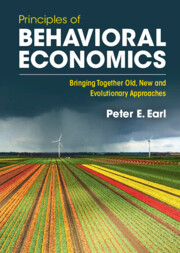Book contents
- Principles of Behavioral Economics
- Principles of Behavioral Economics
- Copyright page
- Contents
- Figures
- Tables
- Preface
- Acknowledgments
- 1 What Is Behavioral Economics?
- 2 What Motivates Us?
- 3 Why Is Life So Full of Problems for Us to Try to Solve?
- 4 How Do We Acknowledge Problems and Assess Options?
- 5 How Do We Deal with Uncertainty and Ambiguity?
- 6 How Do We Search for Solutions to Problems?
- 7 Why Do Some Things Matter More Than Others?
- 8 How Do We Choose?
- 9 How Can Firms and Governments Influence Our Choices?
- 10 What Determines the Productivity of an Organization?
- 11 How Does the Competitive Process Work?
- 12 Are There Any Behavioral Insights for Macroeconomists?
- 13 Can We Be Happy without Destroying the Environment?
- References
- Index
9 - How Can Firms and Governments Influence Our Choices?
Published online by Cambridge University Press: 18 October 2022
- Principles of Behavioral Economics
- Principles of Behavioral Economics
- Copyright page
- Contents
- Figures
- Tables
- Preface
- Acknowledgments
- 1 What Is Behavioral Economics?
- 2 What Motivates Us?
- 3 Why Is Life So Full of Problems for Us to Try to Solve?
- 4 How Do We Acknowledge Problems and Assess Options?
- 5 How Do We Deal with Uncertainty and Ambiguity?
- 6 How Do We Search for Solutions to Problems?
- 7 Why Do Some Things Matter More Than Others?
- 8 How Do We Choose?
- 9 How Can Firms and Governments Influence Our Choices?
- 10 What Determines the Productivity of an Organization?
- 11 How Does the Competitive Process Work?
- 12 Are There Any Behavioral Insights for Macroeconomists?
- 13 Can We Be Happy without Destroying the Environment?
- References
- Index
Summary
In addressing the question of how firms and governments can seek to manipulate behavior, this chapter considers a wider range of perspectives than the “Nudge” approach popularized by Thaler and Sunstein and the “Boost” approach that has recently focused on enhancing decision-making skills rather than on exploiting “supposedly irrelevant factors” that make consumers “predictably irrational.” It thus covers how shopping mall and in-store shopping environments are designed to divert attention to keep shoppers shopping via the “Gruen transfer” process. The chapter also covers the use of product-proliferation strategies aimed at creating “confusopoly” markets and devious strategies such as teaser offers and the shrouding of product add-ons. The highly influential “principles of persuasion” offered by Cialdini are considered, along with the role of sales scripts, emotion-triggering strategies and systems aimed at inducing “ego-depletion” to drive customers to spend more than they had planned. Finally, the chapter introduces economists to the notion of “demarketing,” i.e., strategies for dealing with time-wasting “customers” and excess demand for public services.
Keywords
- Type
- Chapter
- Information
- Principles of Behavioral EconomicsBringing Together Old, New and Evolutionary Approaches, pp. 264 - 294Publisher: Cambridge University PressPrint publication year: 2022

